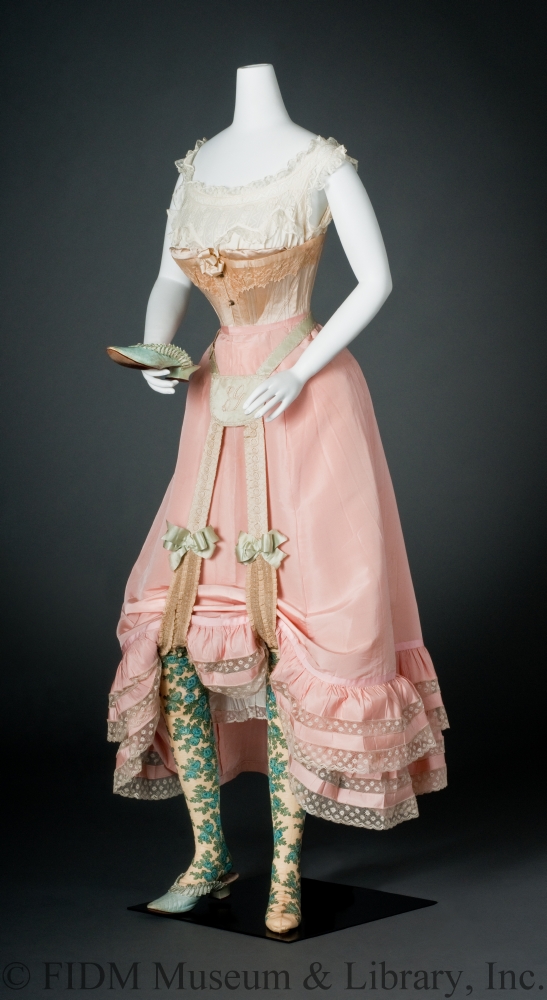Underpinnings, c. 1900-1903
Edwardian era (1901-1910) underclothing was the height of seductiveness, erotic and extravagant. The laborious application of embroidery, lace insertions, and ribbon work onto foundations of silk faille and cotton lawn was excessive for "garments not destined for a public career," and covered by equally elaborate outerwear.1 The distinctive S-bend silhouette popular during this time complemented the Art Nouveau movement's curving, sensuous forms and exaggerated lines. This unnatural shape was achieved by a flat-front corset with a steel busk that dug into its wearer's abdomen, thrusting her hips backward and arching her bosom forward. The waist was cinched as tightly as possible: the effect was literally breathtaking. In risqué postcards and advertising imagery, female models in various states of undress wore petticoats and pantalets alluringly looped up by garter belts, revealing decorative stockings. Though not actually worn as depicted here (the garter belt in fact would be under the petticoat), these bunched-up layers of pastel froufrou mimic this erotic imagery.
In practical terms, carefully fitted undergarments were considered an essential foundation in the quest to create a pleasing silhouette. In 1900, Vogue cautioned readers to make sure they donned appropriate undergarments before trying on a new gown: "we again reiterate the necessity of being properly dressed and corseted before being fitted, and not being fitted in one set of undergarments and wearing quite a different style after the gown in finished."2 For those women who were uncertain about the proper fit and combination of undergarments, "the art of wearing your under garments properly is taught by one of the New York corset makers and is certainly worth knowing, especially if one is not slim."3
The multi-layered undergarment ensemble pictured here features a mix of textures and materials, from cotton lawn to crisp silk taffeta. The cream silk satin corset is worn over a sleeveless chemise. Made from durable cotton, the chemise was a washable layer between the wearer’s body and the less-washable lace and silk corset. Because of their unique construction, corsets were typically purchased, but a woman could make her own chemise. Women's magazines offered readers free patterns with detailed instructions regarding trim, fabric, and sewing methods. For those without the time or inclination to stitch their own undergarments, hiring a skilled seamstress was encouraged.
Made from silk taffeta, the pink petticoat is trimmed with two lace flounces. Constructed with gored panels, the front lies flat against the body while the back features gentle gathers. This fit facilitated the smooth skirt front and full rear that comprised the S-bend silhouette. Mint green embroidered garters anchor silk stockings. Seen only by the wearer and her most intimate associates, the garters feature a purely froufrou touch—exaggerated, decorative bows. With a dense, lively pattern of blue roses and green foliage, the patterned stockings climb the wearers' legs as real roses would climb a trellis. For emphasis, the roses are outlined with a black line. Mint green leather indoor slippers, trimmed with ribbon at the vamp, complete the ensemble.
1 The Lady's Realm (1901) n.p.
2 "Whispers to the Girl With Nothing a Year" Vogue (Oct 4, 1900): 224.
3 Ibid.
